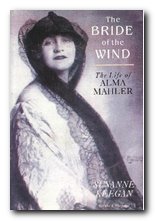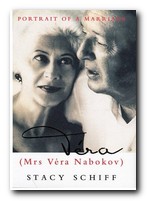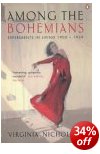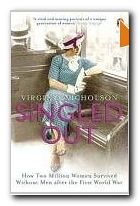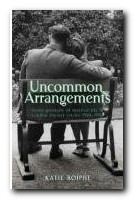poor little rich girl
Peggy Guggenheim came from a family of rich Jewish business people who had made fortunes as immigrants in the nineteenth century from trade, mining, and eventually banking. Her father was a womaniser who died aboard the Titanic in 1913 – putting on his dinner clothes to go down in style. When she was nineteen she inherited five million dollars, though as Mary Dearborn points out in this fairly even-handed biography, everybody assumed that she had even more, and couldn’t understand that by Guggenheim standards she came from a ‘poor’ side of the family.
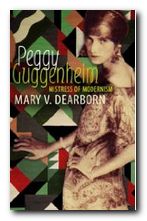 The first thing she spent the money on was an operation to reduce the size of her nose. The procedure went badly wrong and had to be aborted, leaving her worse off than before. In 1921 she married Franco-American Laurence Vail, who introduced her to Bohemian life in the Latin Quarter and in Montmartre. She also met two of his ex-lovers who were to become lifelong friends – Mary Reynolds and Djuna Barnes. Her marriage (the first of many) was a mixture of restless Bohemianism and physical abuse from her husband.
The first thing she spent the money on was an operation to reduce the size of her nose. The procedure went badly wrong and had to be aborted, leaving her worse off than before. In 1921 she married Franco-American Laurence Vail, who introduced her to Bohemian life in the Latin Quarter and in Montmartre. She also met two of his ex-lovers who were to become lifelong friends – Mary Reynolds and Djuna Barnes. Her marriage (the first of many) was a mixture of restless Bohemianism and physical abuse from her husband.
They settled in a house near Toulouse, she had two children, and she sent $10,000 to support the 1926 General Strike in the UK. With Vail she mixed in a fast and arty set: the pages are littered with the names of the now famous – Jean Cocteau, Man Ray, Isodora Duncan, Marcel Duchamp, and Ernest Hemingway – all of whom were happy to share her largesse. She managed to extricate herself from the abusive marriage with the help of her friend and neighbour, Emma Goldmann, the feminist and anarchist. No sooner was this accomplished than she paired off with the Englishman John Holmes who Mary Dearborn describes as “one of the most singularly unproductive men of letters that England may have every known”
There are interesting revelations of the sheer dilettantism which underpins the arty bohemianism of these people. At one point Peggy Guggenheim was trailing across the Atlantic trying to sell decorative lampshades made by her friend Mina Loy.
It’s a life of living in rented houses – in France, England, Switzerland – wherever is fashionable – making visits to America, endless parties, oceans of Champagne, violent rows, fights in restaurants, sexual infidelities – and nobody in sight engaging anything remotely like paid employment.
When John Holmes died unexpectedly (largely of alcohol poisoning) she replaced him with Douglas Garman, another would-be writer, and under his left-wing influence she even joined the Communist Party. A further succession of weekend (and week long) house parties ensued. And rather like the Bloomsbury Group they combined their promiscuity with a curious form of ‘keeping up appearances’ in a bid to preserve social respectability. In common with aristocratic practices, the children produced in these alliances were billeted in outhouses, sent off to boarding schools, raised by paid help, and put unaccompanied on trains to travel half way across Europe at holiday times.
When she got rid of her third abusive husband she began, at forty, what was to become her life vocation. Advised by Marcel Duchamp, she opened a gallery on London devoted to modern art – and surrealism in particular. She began serious collecting, and quickly ammassed a large collection of works by its foremost practicioners, most of whom she knew personally.
In fact many of them either had been or would become her lovers, because free of marriage, she began a mid-life career of sexual emancipation which few would be able to match. Her list of conquests is almost endless: Giorgio Joyce (son of James), Yves Tanguay, Roland Penrose, E.L.T.Mesens, Max Ernst, Marcel Duchamp, and even Samuel Beckett.
By 1940, living in France, she was under serious threat from the Nazis, even though they didn’t seem to realise that she was Jewish. So like many other people she moved to the south then emigrated to America – cleverly arranging for her collection of art works to be sent as ‘household effects’ to avoid tax. Having assembled the collection as a work of love, she wished to put it on show, and despite all the odds she did so in 1942 in New York.
Her concept was novel: it was not just a museum type exhibition, but a living gallery which promoted the work of new young American artists alongside her examples of European art. The gallery was designed to be interactive, and it was a huge success. New York life suited her: she continued to bed men at a prodigious rate, and at one time she lived with a homosexual man with whom she went out on fishing expeditions to pick up sexual partners who they shared.
She exhibited and established the reputations of Mark Rothko, Robert Motherwell, and Jackson Pollock. This was the period in which abstract expressionism swept American modernism into the limelight, propelled by influential critics such as Clement Greenberg and Harold Rosenberg. [See Tom Woolf’s The Painted Word for a sceptical view of the same period.]
And yet almost immediately after the war ended, having established this influential presence in the USA, she closed up shop and decamped to Venice, where she opened the museum that now bears her name. Despite attempts from friends and family alike to deflect her from her purpose, she kept the collection intact, and it now stands as a testament to her personal vision.
In fact last time I visited the gallery it struck me how it encompassed quite a short period of art and a part of the modernist movement which now seems rather tacky – with all the mumbo-jumbo of ‘the unconscious’, the empty posturing of ‘manifestos’, and jejune works by second-rate painters. So the collection is quite an accurate reflection of her life, the later years of which were spent as the grand old lady of the international art scene. But behind the public front of naked sunbathing on the roof of her Grand Canal Palazzo, her gay assistants, and being punted around in the last private gondola in Venice, her real concerns were those of many other elderly ladies the world over – her pet dogs (Lhazo apsos) her wayward children (daughter dead from drugs) and the loneliness of old age.
© Roy Johnson 2009
Mary Dearborn, Peggy Guggenheim: Mistress of Modernism, London: Virago, 2004, pp.448, ISBN 1844080609
More on art
More on media
More on design
